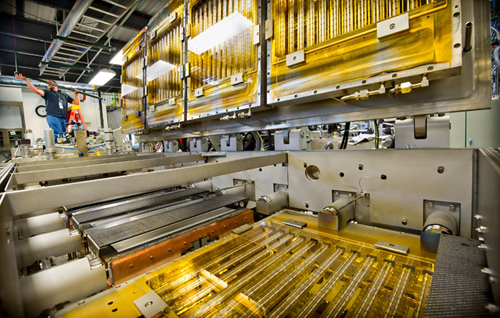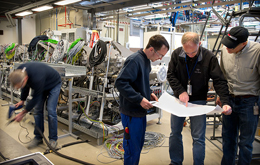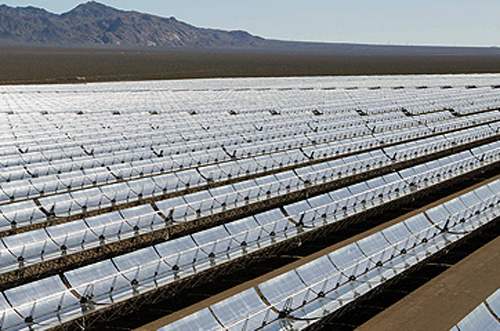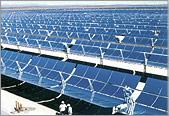Navigation
National Renewable Energy Laboratory Aims to Slash Cost of Solar Cells
- Ampulse Corporation
- carcinogenic chemicals
- concentrating solar power
- crystalline silicon technology global climate change
- National Renewable Energy Laboratory (NREL)
- pollution
- public health
- solar
- solar energy
- solar power
- U.S. Department of Energy's (DOE) )
- Air Pollution
- Energy
- Global Climate Change
- Industry
- Pollution
- Public Health
- Toxic Chemicals
Solar-powered electricity prices could soon approach those of power from coal or natural gas thanks to collaborative research with solar start-up Ampulse Corporation at the U.S. Department of Energy's (DOE) ) National Renewable Energy Laboratory (NREL).
 Ampulse Corporation is installing a pilot production line in the Process Development Integration Laboratory (PDIL) at NREL.: It represents a new, less wasteful way of making solar cells and should result in less expensive devices. Credit: Dennis Schroeder
Ampulse Corporation is installing a pilot production line in the Process Development Integration Laboratory (PDIL) at NREL.: It represents a new, less wasteful way of making solar cells and should result in less expensive devices. Credit: Dennis Schroeder
Solar-powered electricity prices could soon approach those of power from coal or natural gas thanks to collaborative research with solar start-up Ampulse Corporation at the U.S. Department of Energy's (DOE) ) National Renewable Energy Laboratory (NREL).
Silicon wafers account for almost half the cost of today's solar photovoltaic (PV) panels, so reducing or eliminating wafer costs is essential to bringing prices down.
Current crystalline silicon technology, while high in energy conversion efficiency, involves processes that are complex, wasteful, and energy intensive. First, half the refined silicon is lost as dust in the wafer-sawing process, driving module costs higher. A typical 2-meter boule of silicon loses as many as 6,000 potential wafers during sawing. Second, the wafers produced are much thicker than necessary. To efficiently convert sunlight into electricity, they need only one-tenth the typical thickness.
NREL, DOE's Oak Ridge National Laboratory (ORNL), and Ampulse have teamed on an approach to eliminate this waste and dramatically lower the cost of the finished solar panels. The aim is to create a less expensive alternative to wafer-based crystalline silicon solar cells.
By using a chemical vapor deposition process to grow the silicon on inexpensive foil, Ampulse is able to make the solar cells just thick enough to convert most of the solar energy into electricity. No more sawdust — and no more wasting refined silicon materials.
Straight from Pure Silicon to High-Quality Crystal Silicon Film
 Engineers and technicians from Ampulse, NREL, and Roth & Rau: go over plans for installing parts in the pilot production line for making solar cells via a chemical deposition process. Credit: Dennis SchroederNREL developed the technology to grow high-quality silicon.
Engineers and technicians from Ampulse, NREL, and Roth & Rau: go over plans for installing parts in the pilot production line for making solar cells via a chemical deposition process. Credit: Dennis SchroederNREL developed the technology to grow high-quality silicon.
ORNL developed the metal foil that has the correct crystal structure to support that growth.
And Ampulse is installing a pilot manufacturing line in NREL's Process Development Integration Laboratory (PDIL), where solar companies test their latest materials and processes.
With knowledge and expertise acquired from the PDIL pilot production line, Ampulse plans to design a full-scale production line to accommodate long rolls of metal foil.
The Ampulse process "goes straight from pure silicon-containing gas to high-quality crystal silicon film," said Brent Nelson, who runs the PDIL at NREL. "The advantage is you can make the wafer just as thin as you need it — 10 microns or less."
Most of today's solar cells are made out of wafer crystalline silicon, though thin-film cells made of more exotic materials like gallium, arsenic, indium, arsenide, cadmium, and tellurium are making a strong push into the market.
The advantage of silicon is its abundance, as it is derived from sand. Its disadvantage is that purifying it into wafers suitable for solar cells is expensive and energy intensive.
Manufacturers add carbon and heat to sand to produce metallurgical-grade silicon, which is useful in other industries, but not yet suitable for making solar cells. This metallurgical-grade silicon is then converted to pure trichlorosilane (SiCl3) or silane (SiH4) gas.
Typically, the purified gas is converted to create a silicon feedstock at 1,000 degrees Celsius (°C). This feedstock is melted at 1,414°C and recrystallized into crystal ingots that are finally sawed into wafers. Think of it as the Rube Goldberg approach to creating a solar cell.
Instead, the Ampulse process backs up two steps. Rather than create a feedstock, it works with the silane directly and grows just the needed silicon right onto a foil substrate.
Combining NREL's Deposition Technique with ORNL's Textured Foil
 Ampulse's pilot production line is nearly complete at NREL's PDIL.: If the line can make highly efficient solar cells at low cost, the next step will be a full-sized production plant. Credit: Dennis SchroederA team of NREL scientists including Howard Branz and Chaz Teplin had developed a way to use a process called hot-wire chemical vapor deposition to thicken silicon wafers with perfect crystal coatings.
Ampulse's pilot production line is nearly complete at NREL's PDIL.: If the line can make highly efficient solar cells at low cost, the next step will be a full-sized production plant. Credit: Dennis SchroederA team of NREL scientists including Howard Branz and Chaz Teplin had developed a way to use a process called hot-wire chemical vapor deposition to thicken silicon wafers with perfect crystal coatings.
Using a hot tungsten filament much like the one found in an incandescent light bulb, the silane gas molecules are broken apart and deposited onto the wafer using the chemical vapor deposition technique at about 700°C — a much lower temperature than needed to make the wafer. The hot filament decomposes the gas, allowing silicon layers to deposit directly onto the substrate.
Armed with this new technique, Branz and Teplin searched for ways to grow the silicon on cheaper materials and still use it for solar cells.
They found the ideal synergy when visiting venture capitalists from Battelle Ventures asked them whether they could do anything useful with a breakthrough at ORNL called RABiTS (rolling assisted biaxially textured substrate). It was just the opportunity the two scientists had been seeking.
If metal foil is to work as a substrate, it must be able to act as a seed crystal so the silicon can grow on it with the correct structure. The RABiTS process forms crystals in the foil that are correctly oriented to receive the silicon atoms and lock them into just the right positions.
NREL and ORNL worked to combine their technologies using a small amount of funding from Battelle Ventures. Using the right intermediate "buffer layers" to coat the foil substrates, the researchers were able to replicate the desired foil crystal structure in the silicon layer grown over metal foil (epitaxial growth).
Establishing Ampulse Corporation
 A technician handles the many wires and hoses: at Ampulse's pilot production line being installed in NREL's PDIL. Credit: Dennis SchroederWith a commitment to develop the new technology in cooperation with the two national labs, Battelle Ventures and Innovation Valley Partners joined forces to form Ampulse. Initially, Ampulse had very few employees and no offices — just a name, an idea, and a commitment to develop the technology via the unique instrumentation and scientific expertise at the two national labs.
A technician handles the many wires and hoses: at Ampulse's pilot production line being installed in NREL's PDIL. Credit: Dennis SchroederWith a commitment to develop the new technology in cooperation with the two national labs, Battelle Ventures and Innovation Valley Partners joined forces to form Ampulse. Initially, Ampulse had very few employees and no offices — just a name, an idea, and a commitment to develop the technology via the unique instrumentation and scientific expertise at the two national labs.
The company then established a $500,000 cooperative research and development agreement (CRADA) with NREL and a similar agreement with ORNL.
Ampulse also received a total of $900,000 from DOE's Technology Commercialization and Deployment funds at NREL and ORNL. Because Ampulse was started as a company with very low overhead, nearly all its initial funding went toward research efforts at NREL and ORNL.
"Our initial technology success from those funds enabled Ampulse to raise two rounds of venture capital," Branz said.
The company now has 13 employees and six full-time consultants and is currently working with 22 sponsored researchers from two national labs. The first employee at Ampulse, Steve Hane, remains its CEO.
A Giant Step Toward the $1 per Watt Goal?
"We have the potential to produce a 15%-efficient solar cell at less than 50 cents per watt with a fraction of the capital investment of other venture-funded PV companies," Hane said. "And that's due to our R&D collaborations with the national labs." Hane said the unique relationship between the national labs and venture capitalists should be a model for future technology transfers to the private sector.
Recently, with its SunShot Initiative, DOE challenged researchers to lower the cost of solar energy by two-thirds to $1 per watt installed. By eliminating costly silicon wafers — but still using silicon as the core material — the Ampulse approach has the potential to meet this target.
"The trick is to get as good material quality as you have in a wafer," Teplin said. "We're using our existing knowledge of how to grow silicon directly from a gas phase onto these metal foils."
Production Line Features Vacuum Chambers and Quartz Lamps
The production line being installed at NREL's PDIL consists of a half dozen cube-like vacuum chambers where foils are overcoated with buffer and silicon layers to fabricate solar cells. It was built to Ampulse's specifications by Roth & Rau Microsystems of Germany.
The new production system will also exchange samples with other NREL research and analysis equipment in the PDIL. NREL's "wafer replacement tool" will be connected to the Ampulse system and will have a robot that can retrieve samples while maintaining vacuum, preventing exposure of the sample to air.
To fabricate solar cells, metal foils are loaded into the Ampulse system, where quartz lamps heat them to a temperature of 850°C. First, the foils are coated with the necessary buffer layers. Then, the samples are transferred to a specially designed chamber where the key silicon layers are grown. The silicon is then exposed to atomic hydrogen to improve its electronic properties. Finally, solar cell junction and electrical contacts are developed.
"With this new tool, we will be able integrate NREL and ORNL technologies seamlessly and quickly," Teplin said. "Further, with access to all of NREL's other PDIL capabilities, we really expect technological progress to accelerate."
Branz summed up: "The main thing is that we can grow high-quality silicon layers very fast and without putting much energy into the process. That means the solar cells can turn out much cheaper than the wafer-based cells."
"Our process goes directly from gas to the epitaxial silicon phase, bypassing the growth and sawing phase," Ampulse's Director of Planning and Logistics, Mike Colby, said. "We made it large because we needed to demonstrate the scalability of the system."
"To accelerate time to market, we need to maximize the cycle speed," Colby added. "The goal is to achieve the crystal silicon performance that until now focused on thicker wafers — and without having to use a 1,400°C furnace."
As skilled technicians tweaked the knobs of the potentially game-changing prototyping line, Colby said, "We've had good luck and a good relationship with NREL. The aim of NREL, and of the PDIL, is to work with the needs of business and help accelerate commercialization of new technologies. This definitely does that."
This news is from National Renewable Energy Laboratory (NREL), 5 March 2012. Article by Bill Scanlon
Learn more about solar energy research at NREL.
NREL is a national laboratory of the U.S. Department of Energy, Office of Energy Efficiency and Renewable Energy operated by the Alliance for Sustainable Energy, LLC.
NREL is the only federal laboratory dedicated to the research, development, commercialization and deployment of renewable energy and energy efficiency technologies.
NREL Resources
 Utilities across the country are offering solar electricity to their customers as a viable source of clean energy.
Utilities across the country are offering solar electricity to their customers as a viable source of clean energy.
Programs and Initiatives
The SunShot Program strives to make solar energy technologies cost-competitive by 2020. To learn more, visit the SunShot website or read the fact sheet![]() .
.
Utility Solar Water Heating Initiative gets solar heating into the marketplace.
U.S. Department of Energy Solar Decathlon challenges 20 collegiate teams to design, build, and operate solar-powered houses that are cost-effective, energy-efficient, and attractive.
Using Solar Energy
 Using Solar Energy
Using Solar Energy
· Homeowners
· Builders
Information Resources
Parabolic Trough Technology
Parabolic trough solar technology offers the lowest cost solar electric option for large power plant applications.
 Solar Field
Solar Field
To learn more, read our technology overviews:
Parabolic Trough Data and Resources
·
TroughNet
TroughNet is a technical resource for evaluation of parabolic trough solar power plant technologies.
TroughNet is developed by the National Renewable Energy Laboratory's Solar Energy Technologies Program under the Electricity, Resources, and Building Systems Integration Center.
Learn more about NREL's concentrating solar power research.
Parabolic Trough Technology Solar Resource Data and Tools
Here you'll find resources on solar radiation data and tools for siting parabolic trough power plants. This includes solar radiation data for power plants in the United States and worldwide.
You'll also find resources for direct solar radiation instrumentation.
For an overview on solar resource terms and direct beam radiation used for concentrating solar power technologies, see NREL's Shining On Web site.
U.S. Solar Radiation Resource Data
The following resources include maps, and hourly metrological and solar resource data for parabolic trough power plants sites in the United States.
NREL Concentrating Solar Power Resource Maps 
Features direct normal solar radiation maps of the southwestern United States, including state maps for Arizona, California, Colorado, New Mexico, and Nevada.
NREL Measurement and Instrumentation Data Center 
Provides access to a number of irradiance and meteorological data stations. Live data is available from a number of stations across the United States.
NREL Solar Radiation Resource Information 
Provides access to extensive solar resource data sets, solar models, solar spectra, publications, and more.
NREL Typical Meteorological Year Data 
Provides typical meteorological year (TMY2) data sets derived from the 1961-1990 National Solar Radiation Data Base (NSRDB). The TMY2 data sets represent a "typical" year that is representative of the 30-year period for each NSRDB site.
For each NSRDB site, you can download TMY2 documentation and hourly data sets that include both solar and weather data.
Perez Satellite Solar Resource Data Set
Provides satellite-derived, high-resolution solar radiation data for the United States from 1998-2005. It uses visible channel images from GOES to estimate ground irradiance—a method proven comparable to models using ground-based cloud observations.
The model produces a gridded data set with pixels at 0.1 degree intervals (about 10x10 km) for all 50 states, excluding Alaska north of 60° North latitude and west of 160° West longitude (see Annual Map).
Perez direct normal irradiance (DNI) data is available on NREL's U.S. Atlas of Renewable Resources. Open the 10km/Direct Normal Layer folder.
National Solar Radiation Data Base 
Includes a 30-year weather and solar radiation data set for 239 sites across the United States for the period 1960-1990. Note: most of the direct normal solar data is modeled data.
Also, see NREL's Solar Radiation Data for Flat-Plate and Concentrating Collectors.
You can purchase full NSRDB data, including weather data, from the National Climatic Data Center.
International Solar Resource Data
The following resources provide solar resource data for parabolic trough power plant sites around the world.
Solar and Wind Energy Resource Assessment 
Provides high-quality renewable energy resource information online for select countries and regions around the world. SWERA also has maps of monthly and annual direct normal irradiance (DNI) and other solar parameters at a 40-km resolution for Africa, South and Central America, China, India, and Southeast Asia.
In addition, hourly modeled data from surface stations, and typical meteorological years (TMYs), are available for select countries, including China, Brazil, Cuba, Nicaragua, El Salvador, Honduras, Guatemala, Ghana, Kenya, Ethiopia, Sri Lanka, Bangladesh, and Nepal.
NASA Solar Data Analysis Center 
Provides data for concentrating solar power technologies.
NASA Surface Meteorology and Solar Energy 
Provides data for concentrating solar power applications based on satellite cloud modeling, which is done on a 100-km spatial resolution. Data are available for any location in the world.
SOLEMI - Solar Energy Mining 
Provides high-quality irradiance data for the solar energy community. This service from the German Aerospace Center (DLR) is mainly based on Meteosat-data with a nominal spatial resolution of 2.5 km and half-hourly temporal resolution.
Solar radiation maps and an hourly time series will be available for almost half of the Earth's surface.
Direct Normal Solar Radiation Instrumentation
The following resources provide information on instrumentation to measure direct normal solar radiation for parabolic trough power plants.
University of Oregon - Rotating Shadowband Pyranometer 
Offers a low-cost option of measuring solar radiation resources for renewable energy applications.
Historically, pyrheliometers have been used for measuring the direct normal solar beam radiation. For more information, DLR's Web site features a paper on Comparison of Different Methods for Measuring Solar Irradiation Data (PDF 385 KB). Download Adobe Reader.
Normal Incidence Pyrheliometer 
Provides a traditional approach for measuring the direct normal irradiance (DNI). The Normal IncidencePyrheliometer (NIP) requires accurate two-axis tracing and frequent cleaning to assure good quality data collection.
Also, see NREL's NIP instrument descriptions and histories.
NREL Metrology Laboratory-Instrument Calibrations 
Provides improved confidence in the quality of direct normal irradiance (DNI) measurements. NREL can prove the calibration of instruments against known standards.
NREL Solar Radiation Research Laboratory 
Provides a unique outdoor research facility for supporting renewable energy conversion technologies and climate change studies.
For a history of this facility, read 20 Years of Solar Measurements: The Solar Radiation Research Laboratory (PDF 672 KB). Download Adobe Reader.
Search
Latest articles
Agriculture
- World Water Week: Healthy ecosystems essential to human health: from coronavirus to malnutrition Online session Wednesday 24 August 17:00-18:20
- World Water Week: Healthy ecosystems essential to human health: from coronavirus to malnutrition Online session Wednesday 24 August 17:00-18:20
Air Pollution
- "Water and Sanitation-Related Diseases and the Changing Environment: Challenges, Interventions, and Preventive Measures" Volume 2 Is Now Available
- Global Innovation Exchange Co-Created by Horizon International, USAID, Bill and Melinda Gates Foundation and Others
Biodiversity
- It is time for international mobilization against climate change
- World Water Week: Healthy ecosystems essential to human health: from coronavirus to malnutrition Online session Wednesday 24 August 17:00-18:20
Desertification
- World Water Week: Healthy ecosystems essential to human health: from coronavirus to malnutrition Online session Wednesday 24 August 17:00-18:20
- UN Food Systems Summit Receives Over 1,200 Ideas to Help Meet Sustainable Development Goals
Endangered Species
- Mangrove Action Project Collaborates to Restore and Preserve Mangrove Ecosystems
- Coral Research in Palau offers a “Glimmer of Hope”
Energy
- Global Innovation Exchange Co-Created by Horizon International, USAID, Bill and Melinda Gates Foundation and Others
- Wildlife Preservation in Southeast Nova Scotia
Exhibits
- Global Innovation Exchange Co-Created by Horizon International, USAID, Bill and Melinda Gates Foundation and Others
- Coral Reefs
Forests
- NASA Satellites Reveal Major Shifts in Global Freshwater Updated June 2020
- Global Innovation Exchange Co-Created by Horizon International, USAID, Bill and Melinda Gates Foundation and Others
Global Climate Change
- It is time for international mobilization against climate change
- It is time for international mobilization against climate change
Global Health
- World Water Week: Healthy ecosystems essential to human health: from coronavirus to malnutrition Online session Wednesday 24 August 17:00-18:20
- More than 400 schoolgirls, family and teachers rescued from Afghanistan by small coalition
Industry
- "Water and Sanitation-Related Diseases and the Changing Environment: Challenges, Interventions, and Preventive Measures" Volume 2 Is Now Available
- Global Innovation Exchange Co-Created by Horizon International, USAID, Bill and Melinda Gates Foundation and Others
Natural Disaster Relief
- STOP ATTACKS ON HEALTH CARE IN UKRAINE
- Global Innovation Exchange Co-Created by Horizon International, USAID, Bill and Melinda Gates Foundation and Others
News and Special Reports
- World Water Week: Healthy ecosystems essential to human health: from coronavirus to malnutrition Online session Wednesday 24 August 17:00-18:20
- STOP ATTACKS ON HEALTH CARE IN UKRAINE
Oceans, Coral Reefs
- World Water Week: Healthy ecosystems essential to human health: from coronavirus to malnutrition Online session Wednesday 24 August 17:00-18:20
- Mangrove Action Project Collaborates to Restore and Preserve Mangrove Ecosystems
Pollution
- Zakaria Ouedraogo of Burkina Faso Produces Film “Nzoue Fiyen: Water Not Drinkable”
- "Water and Sanitation-Related Diseases and the Changing Environment: Challenges, Interventions, and Preventive Measures" Volume 2 Is Now Available
Population
- "Water and Sanitation-Related Diseases and the Changing Environment: Challenges, Interventions, and Preventive Measures" Volume 2 Is Now Available
- "Water and Sanitation-Related Diseases and the Changing Environment: Challenges, Interventions, and Preventive Measures" Volume 2 Is Now Available
Public Health
- Honouring the visionary behind India’s sanitation revolution
- Honouring the visionary behind India’s sanitation revolution
Rivers
- World Water Week: Healthy ecosystems essential to human health: from coronavirus to malnutrition Online session Wednesday 24 August 17:00-18:20
- Mangrove Action Project Collaborates to Restore and Preserve Mangrove Ecosystems
Sanitation
- Honouring the visionary behind India’s sanitation revolution
- Honouring the visionary behind India’s sanitation revolution
Toxic Chemicals
- "Water and Sanitation-Related Diseases and the Changing Environment: Challenges, Interventions, and Preventive Measures" Volume 2 Is Now Available
- Actions to Prevent Polluted Drinking Water in the United States
Transportation
- "Water and Sanitation-Related Diseases and the Changing Environment: Challenges, Interventions, and Preventive Measures" Volume 2 Is Now Available
- Urbanization Provides Opportunities for Transition to a Green Economy, Says New Report
Waste Management
- Honouring the visionary behind India’s sanitation revolution
- Honouring the visionary behind India’s sanitation revolution
Water
- Honouring the visionary behind India’s sanitation revolution
- Honouring the visionary behind India’s sanitation revolution
Water and Sanitation
- Honouring the visionary behind India’s sanitation revolution
- Honouring the visionary behind India’s sanitation revolution

